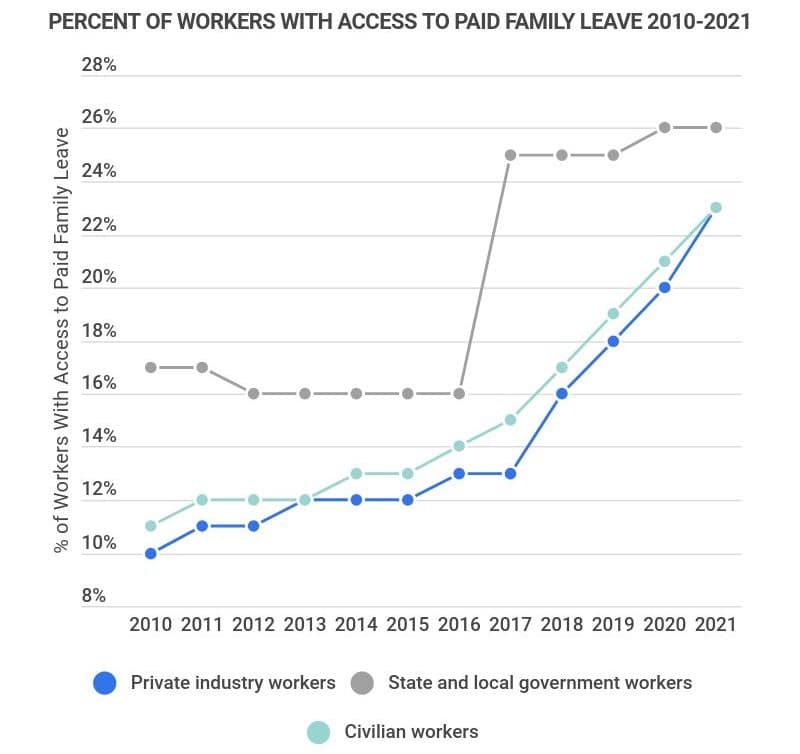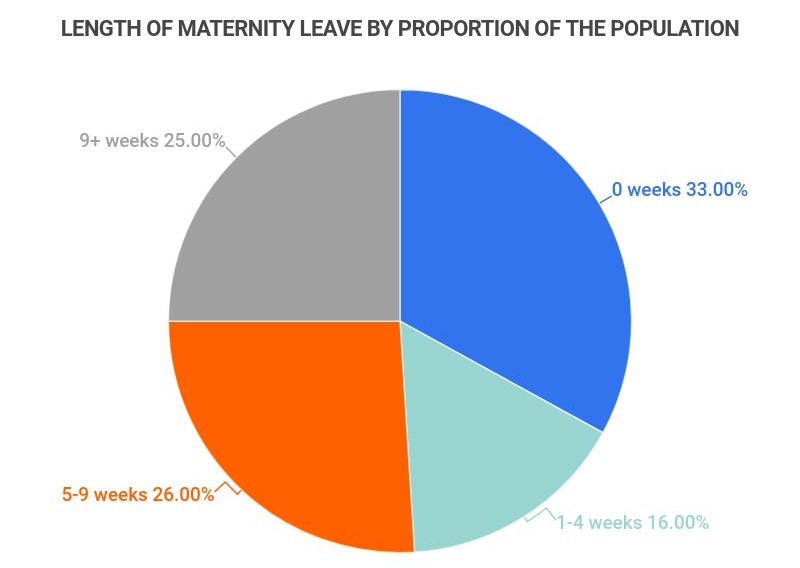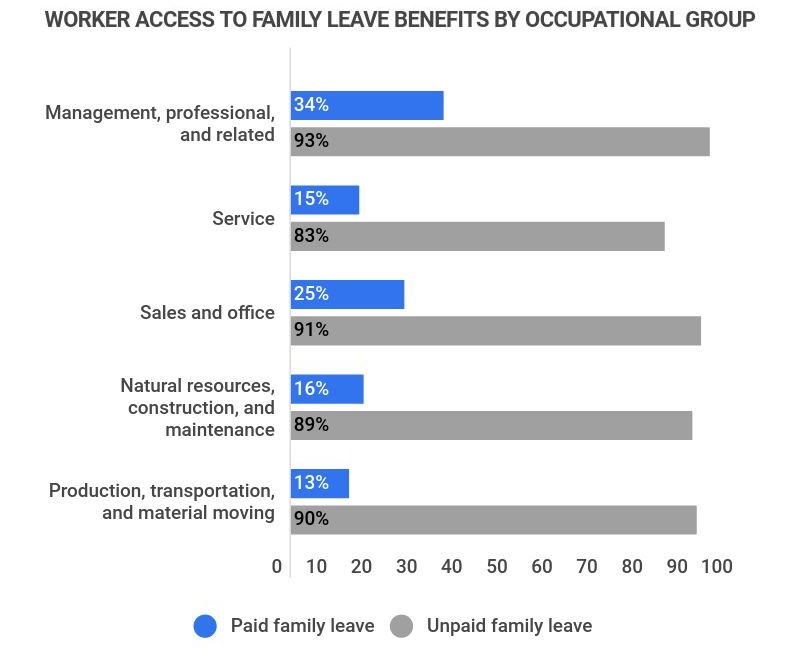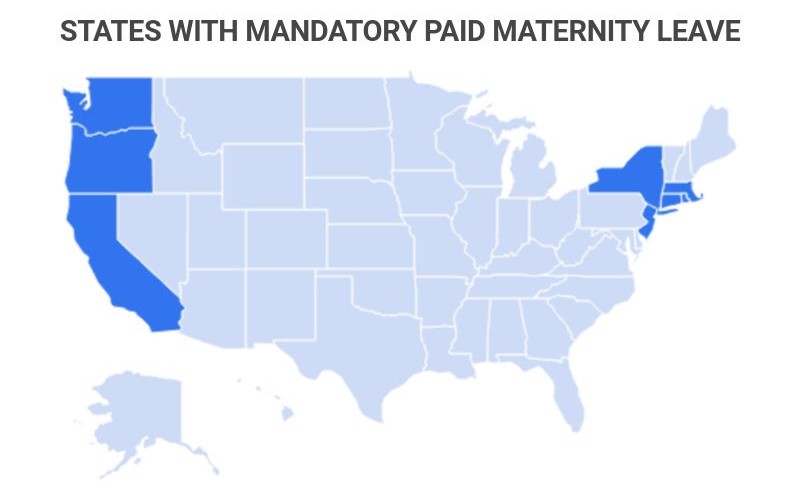- HR Statistics
- Average Labor Cost Percent Of Sales
- Average Time to Reach Profitability At A Startup
- Office Space Per Employee
- Recruitment Statistics
- Employee Engagement Statistics
- Work-Life Balance Statistics
- BYOD Statistics
- Paternity Leave Statistics
- Onboarding Statistics
- Average Paid Maternity Leave In Us
- Average Cost Of A Bad Hire
- Employee Theft Statistics
- Paid Family Leave Statistics
- Cost Of Hiring Statistics
- Employee Turnover Statistics
- Average Cost Of Employer Sponsored Health Insurance Statistics
- Sexual Harassment In The Workplace Statistics
- HR Statistics
- PTO Statistics
- Social Media Recruitment Statistics
- Hiring Statistics
- Out Of Prison Employment Statistics
Research Summary. People often talk about how the U.S. is behind other countries on paid maternity leave, but is this really the case? For the most part, yes. A majority of American workers still don’t have access to paid maternity leave, and the typical maternity leave policy offers far less time-off compared to other countries.
To find out more about common maternity leave policies in the U.S., we’ve gathered all of the most essential facts and statistics. According to our extensive research:
-
23% of those working in private industries have access to paid maternity leave.
-
8 weeks is the average amount of paid maternity leave given by companies, but this isn’t mandated by law. Federal law only requires 12 weeks of unpaid leave.
-
40% of employers offer paid maternity leave in some form.
-
70% of women take some form of maternity leave.
-
The average maternity leave in the US is 10 weeks, paid or unpaid.
-
82% of Americans want some form of a federal paid maternity leave policy.
For further analysis, we broke down the data in the following ways:
Unpaid vs. Paid | Industry | Company Size | Region

Percent of Workers With Access to Paid Family Leave 2008-2021
| Year | Private Industry Workers | State And Local Government Workers | Civilian Workers |
|---|---|---|---|
| 2021 | 23% | 26% | 23% |
| 2020 | 20% | 26% | 21% |
| 2019 | 18% | 25% | 19% |
| 2018 | 16% | 25% | 17% |
| 2017 | 13% | 25% | 15% |
| 2016 | 13% | 16% | 14% |
| 2015 | 12% | 16% | 13% |
| 2014 | 12% | 16% | 13% |
| 2013 | 12% | 16% | 12% |
| 2012 | 11% | 16% | 12% |
| 2011 | 11% | 17% | 12% |
| 2010 | 10% | 17% | 11% |
General Paid Maternity Leave Statistics
When it comes to paid maternity leave, the U.S. falls short compared to many other countries. While the Family and Medical Leave Act (FMLA) of 1993 did provide mandatory unpaid maternity leave, many still believe this isn’t nearly enough. Here are the facts:
-
The FMLA provides 12 weeks of unpaid maternity leave, but only for those who are eligible.
And these eligibilities include: working at the company for a minimum of 12 months, working at least 1,250 hours over that period, and working at a location where 50 or more employees operate there, or within 75 miles.
In comparison, North Korea guarantees women 240 days of unpaid maternity leave, about three times as much as the United States of America.
-
The average paid maternity leave in countries that are a part of the Organization of Economic Cooperation and Development (OECD) is 18 weeks.
This includes countries like Mexico, Australia, Canada, and almost all of Europe. The U.S. is the only member of the OECD that doesn’t offer mandatory paid maternity leave.
-
36 countries in Europe and Asia offer 52+ weeks of paid maternity leave. The U.S. offers 0.
The highest of these countries being Estonia (84 weeks), Bulgaria (70 weeks), Hungary (68 weeks), and Lithuania (62 weeks). During this period, employers in those countries are required to pay employees.
-
More than 120 countries require paid maternity leave by law.
Of these countries, a majority follow The International Labor Organization (ILO), which expects 12-14 weeks of paid maternity leave. The U.S. is an exception here, as it’s one of only 33 countries that offer less than 12 weeks of paid maternity leave. Even worse, the U.S. actually has no mandatory paid maternity leave.
-
The US is 1 of 7 countries in the world with no guaranteed paid parental leave.
The other six countries are Papua New Guinea, Micronesia, the Marshall Islands, Nauru, Palau, and Tonga. The US is an outlier in this group as the only wealthy nation.

Unpaid and Paid Maternity Leave Statistics
Given that the U.S. is behind other countries regarding paid maternity leave, does this affect how new mothers use it? Yes, as new mothers in the United States take surprisingly little time off. Here are some insights our research uncovered:
-
Only 25% of women take nine weeks or longer of maternity leave, paid or unpaid.
Likely due to the lack of paid maternity leave, many American mothers take off far less than 12 weeks of maternity leave. In fact, only 51% of women only take 5 or more weeks off for maternity leave.
-
1/3 of U.S. women don’t take maternity leave.
Somewhat shockingly, 1/3 of new mothers take little to no time off after giving birth to or adopting their new child and instead opt to return to work as soon as they’re able.
-
Lower-income women are 58% more likely not to take maternity leave.
Among women who make less than $30,000 per year, 62% do not take maternity leave. However, among women who make at least $75,000 annually, that number is only 26%.
-
Experts recommend at least 6 months to a year of paid maternity leave.
However, even left-leaning lawmakers in the U.S. are only proposing 12 weeks of paid maternity leave and are currently having little success.
-
Women and their families lose an estimated $22.5 billion in wages each year due to the lack of mandatory paid maternity leave.
That equates to the average adult losing between $9,578 in wages after taking 12 weeks of paid maternity leave, typically 58% of their quarterly income.

Length of Maternity Leave by Proportion of the Population
| Length Of Leave | Percentage Of New Moms |
|---|---|
| 0 weeks | 33% |
| 1-4 weeks | 16% |
| 5-9 weeks | 26% |
| 9+ weeks | 25% |
Paid Maternity Leave by Industry Statistics
Though paid maternity leave can be hard to come by in the United States, some industries and fields offer it more than others. According to our research:
-
The Architecture and Engineering industry has 6 of the top 11 fields that offer paid maternity leave.
And of these fields, the Senior Reliability Engineer field is the most likely to offer maternity leave, with an average of 30% of job listings offering it. Another top field is Lead Engineer, with 25% of listings offering paid maternity leave.
-
Food Preparation and Serving Related Occupations are the least likely to offer paid maternity leave.
Of the listed jobs, there are no jobs in this industry that offer paid maternity leave. Most listings for fields in other industries have at least a 1% chance of offering maternity leave, but for cooks and servers, that number is 0.
-
Management and professional workers have the highest rate of paid family leave access at 34%.
Meanwhile, those who work in production, transportation, and material moving have the lowest rate of paid family leave access at 13%.
The service industry, at 83%, has the lowest rate of unpaid family leave access.
Jobs With the Highest Rate of Paid Maternity Leave
| Job | % of job listings |
|---|---|
| Senior Reliability Engineer | 30% |
| Lead Engineer | 25% |
| Electronics Technician | 20% |
| Senior Recruiter | 20% |
| Technical Support Engineer | 20% |
Jobs With the Lowest Rate of Paid Maternity Leave
| Job | % of job listings |
|---|---|
| Cook | 0% |
| Server | 0% |
| Sales Engineer | 1% |
| Case Manager | 1% |
| Architect | 1% |

Paid Maternity Leave by Company Size Statistics
Whether you work for a private company or the government can also impact your chances of receiving paid maternity leave. In general, federal employees have far more access. Here’s what we found:
-
Freddie Mac is the top company in the U.S. for paid maternity leave, offering a full 12 weeks to employees.
This government-backed loan and mortgage corporation offers new mothers 12 weeks of paid maternity leave and provides up to $30,000 to help parents pay for adoption fees. On top of that, Freddie Mac also has a lactation support program for breastfeeding mothers.
-
Only 15% of companies with 99 or fewer employees offer paid maternity leave.
But many claim this is because they can’t compete with larger corporations. 70% of small businesses support a national paid leave policy.
-
40% of private companies in the U.S. offer paid maternity leave.
However, this doesn’t mean that everyone has access to benefits. On average, only 23% of private employees have access to these programs.
-
2.1 million federal employees have access to paid maternity leave.
That’s about 70% of all federal workers.
Paid Maternity Leave by Region Statistics
Last, but not least, because the states have so much autonomy in the U.S., there can be a huge difference in maternity leave between them. For instance, states like Massachusetts and California offer more paid maternity leave than Florida. Here are the facts for paid maternity leave for different states:
-
As of 2020, Massachusetts offers the best paid maternity leave, providing up to 12 weeks of mandatory paid leave.
In 2019, Massachusetts passed the Massachusetts Paid Family and Medical Leave Act (MA PFML) which granted up to 12 weeks of paid maternity leave for eligible employees. California also has a similar policy.
-
Only 8 states provide access to paid maternity leave.
California, New Jersey, Massachusetts, Rhode Island, New York, Washington, Connecticut, and Oregon.
-
Louisiana is one of the worst states for paid maternity leave, with 63% of working people in the state not having access.
Due to the lack of a paid maternity leave policy and at least one major qualification loophole, most people in this state don’t have access to paid maternity leave.

Paid Maternity Leave FAQ
-
What is the average unpaid maternity leave?
The average unpaid maternity leave in the U.S. is 12 weeks. However, many new mothers opt to take less than 9 weeks of leave because few have access to paid leave. The truth is that for many mothers, the idea of taking up to 12 weeks off with no pay would be catastrophic for them financially.
-
How many U.S. companies offer paid maternity leave?
Roughly 40% of private companies in the U.S. offer paid maternity leave. Of these, there are around 180 major companies with significant paid maternity leave policies. These include companies like Amazon, Google, Freddie Mac, and more.
-
Is maternity leave paid in the U.S.?
No, maternity leave is not typically paid in the U.S. Unfortunately, only 23% of those working in private industries have access to paid maternity leave in the United States. The FMLA only requires companies to offer 12 weeks of unpaid maternity leave.
While there are 8 states that do have paid maternity leave policies, and many federal employees have access, the U.S. still offers very little compared to other developed countries.
-
The FMLA or Family and Medical Leave Act was passed in 1993 and provides 12 weeks of unpaid maternity leave for eligible employees.
To be eligible, employees must have worked at the company for a minimum of 12 months, worked at least 1,250 hours over that period, and worked at a location where 50 or more employees operate there or within 75 miles.
-
Can I get maternity leave if I just started a job?
Yes, you can get maternity leave if you just started a job. Though, keep in mind that the company will be under no legal obligation to do so. To be eligible for the FMLA, you need to work for a company for at least 1 year or have worked for them for 1,250 hours (a bit more than 7 months of full-time employment or 9.5 months of part-time employment) over the past year.
The company also needs to have at least 50 employees operating there or within 75 miles.
Still, companies are free to offer any parental leave policies that they want, so you might be able to take maternity leave soon after starting a new job. Don’t feel obligated to share your family planning with hiring managers, but do take note of the company’s policy surrounding maternity leave during the hiring process.
-
Can you work another job while on maternity leave?
Yes, you can work another job while on maternity leave. The FMLA has no stipulations preventing an employee from working for a different employer during their 12-week unpaid family leave.
However, companies are still free to have policies that prohibit employees from working for different employers. These policies remain in effect while an employee is taking time off under the FMLA.
-
Can you be denied a job for being pregnant?
No, you cannot be denied a job for being pregnant. The Pregnancy Discrimination Act of 1978 prohibits employers from discriminating based on pregnancy or pregnancy-related conditions.
However, an employer is still under no obligation to extend FMLA benefits to a new hire.
-
What am I entitled to if I don’t return to work after maternity leave?
If you don’t return to work after maternity leave, you’re still entitled to pay for any unsed paid time off and COBRA benefits. It’s best to still follow company policy and common decency by giving adequate notice of your decision not to return.
However, you may have to pay back health insurance premiums if they were used to cover health expenses over your maternity leave (which they likely were). This right to reimbursement doesn’t apply if you return to work for at least 30 days.
Conclusion
When it comes to paid maternity leave, the U.S. lags far behind the 36 countries in Europe and Asia that offer 52+ weeks of paid maternity leave. Instead, the FMLA in the U.S. only requires 12 weeks of unpaid maternity leave to be offered. The lack of a federal paid maternity leave policy means that only 23% of private employees have access.
However, the lack of an overarching policy also creates large disparities between private and federal employees and employees from different states or companies. For example, states like Massachusetts require at least 12 weeks of paid maternity leave for eligible employees, while loopholes in Louisiana leave 63% of employees without access to maternity leave.
Luckily, things seem to be moving in the right direction. Of the 8 states that now have mandatory paid leave, many of which have passed these policies within the past two years. On top of that, 70% of small businesses support a national paid leave policy, despite only 15% of their employees having access right now.
With the implementation of more paid maternity leave policies, the U.S. could see a shift in the number of people who have access.
Sources:
-
UCSF. “National Paid Maternity Leave Makes Sense for Mothers, Babies and Maybe the Economy.” Accessed on September 14th, 2021.
-
The Balance Careers. “How Long Is the Average Maternity Leave?” Accessed on September 14th, 2021.
-
U.S. Department of Labor. “Frequently Asked Questions and Answers About the Revisions to the Family and Medical Leave Act.” Accessed on September 14th, 2021.
-
Insider. “Here’s what maternity leave looks like around the world.” Accessed on September 14th, 2021.
-
PEO Worldwide. “Maternity and Paternity Pay Around the World.” Accessed on September 14th, 2021.
-
CNN. “Paid leave for parents: What’s the right amount of time?” Accessed on September 14th, 2021.
-
Center for American Progress. “The Rising Cost of Inaction on Work-Family Policies.” Accessed on September 14th, 2021.
-
Zippia. “The Best (and Worst) Jobs for Maternity Leave.” Accessed on September 15th, 2021.
-
Insider. “10 of the best companies for new parents, including Amazon, Microsoft, and Freddie Mac.” Accessed on September 15th, 2021.
-
HBR. “How Small Companies Can Offer Great Paid-Leave Programs.” Accessed on September 15th, 2021.
-
Talentculture. “60 Percent of U.S. Companies Still Don’t Offer Paid Paternity Leave.” Accessed on September 15th, 2021.
-
World Population Review. “Paid Maternity Leave By State 2021.” Accessed on September 15th, 2021.
-
CNBC. “These are the best and worst states for working moms in 2021, according to new report.” Accessed on September 15th, 2021.
-
BLS. “What data does the BLS publish on family leave?”. Accessed on January 6, 2022
- HR Statistics
- Average Labor Cost Percent Of Sales
- Average Time to Reach Profitability At A Startup
- Office Space Per Employee
- Recruitment Statistics
- Employee Engagement Statistics
- Work-Life Balance Statistics
- BYOD Statistics
- Paternity Leave Statistics
- Onboarding Statistics
- Average Paid Maternity Leave In Us
- Average Cost Of A Bad Hire
- Employee Theft Statistics
- Paid Family Leave Statistics
- Cost Of Hiring Statistics
- Employee Turnover Statistics
- Average Cost Of Employer Sponsored Health Insurance Statistics
- Sexual Harassment In The Workplace Statistics
- HR Statistics
- PTO Statistics
- Social Media Recruitment Statistics
- Hiring Statistics
- Out Of Prison Employment Statistics






